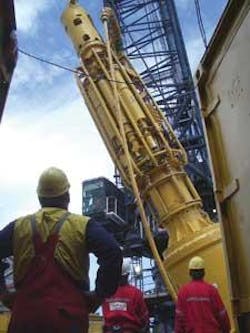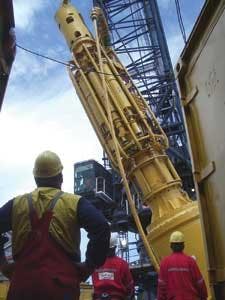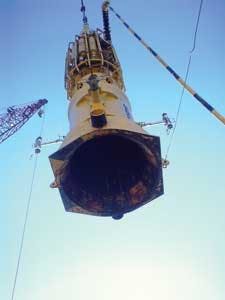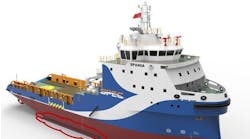In late 2007, Technip installed the driven-pile anchors for Murphy Oil’s Kikeh spar platform in more than 1,300 m (4,265 ft) of water off eastern Malaysia.
The installation was performed using a Menck MHU 500T hammer. According to Menck, no other hammer systems can operate at this depth, although that was not the main issue on this project. What made this installation different was that for the first time, the entire operation was performed fromRockwater II, a dynamic positioning Class 2 monohull vessel, instead of from the more conventional – and more expensive – Class 3 semisubmersible crane barge.
According to Lutz Micheel, Menck project manager, “The main challenge we faced was shortage of space. On theSaipem 7000, for example, the deck area is around 9,000 sq m (96,875 sq ft); on the Rockwater II it is only 1,150 sq m (12,387 sq ft), and we were not allowed to monopolize this space.
“We succeeded in getting the hammer and its underwater power pack, plus all our supporting equipment, into an area no greater than 400 sq m (4,306 sq ft). However, the confined conditions on the deck of the vessel meant we did not have the luxury of a back-up hammer on this project, and so mechanical reliability was paramount.”
The other challenge for the eight-man hammer support team concerned the lifting equipment on the boat, a 150-ton (136-metric ton) crane with a 13 m (42.6 ft) radius of operation, and only 475 m (1,558 ft) of wire.
“Again, this was inconvenient,” says Micheel, “but not something we could not deal with. Our MHU 500T hammer with its MUP-01 power pack weighs only 107 tons [98 metric tons] in air, and the way we have designed the hammer’s trunnions meant that upending the unit to get it over the side of the boat was reasonably easy.
“To overcome the shortage of wire on the crane, Technip lowered the hammer to working depth using extension pennants. It was subsequently kept there for the 10 days required to complete the project. The fact that the piles had been previously stabbed into the seabed, and so did not need to be lowered with the hammer, was also in our favor.”
Technip used the hammer to install 84-in. (213-cm) diameter mooring piles for the spar and four piles for a tender-assist drilling rig, in four clusters around 3 km (1.86 mi) apart, and in a total driving time of just over 21 hours.
“The project was a complete success from our standpoint,” Micheel adds. “Most importantly, it was free of any safety or environmental incidents. It also proved that the hammer could be deployed from a less costly vessel with generally better availability than from the large crane barges normally hired for this type of work.”
Menck’s deepest pile-driving installation was for Kerr McGee’s Constitution spar in 1,564 m (5,131 ft) water depth. The company is able to work in these depths using its MUP electrically drive hydraulic power system, designed to fit around the hammer like a girdle. It is connected to the surface by an umbilical delivering electric power, compressed air, and communications.
The current depth limit for the MHU T series is 2,000 m (6,562 ft), although the company is developing the “U” series to operate in up to 3,000 m (9,842 ft) using the existing MUP power pack.
Caisson/template connections
Menck also supported sister company InterMoor earlier this year on Shell Brasil’s Parque das Conchas fields in the Espirito Santo basin. The scope of work included installing 11 36-in. (91.4-cm) diameter, 50-m (164-ft) drilling conductors, two templates, a caissons guide, and a foundation for an artificial gas lift manifold in water depths of 1,600–1,800 m (5,249–5,905 ft). Six 48-in (122-cm) diameter, 60-m (197-ft) caissons were installed and driven through the template.
InterMoor deployed a customized transport/launch barge for the installation, using a specially designed conductor side-launch system for keelhauling the conductors to the anchor handling vessel. It also applied its compensated anchor-handler subsea installation method to maximize control of the conductor installation operation from the vessel. This included performing dynamic lowering analyses on the conductors and the Menck MHU-270T deepwater hammer, which provides a driving energy of 270 kJ at 1,000 m (3,281 ft) water depth.
Generating hydraulic power at depth, rather than at the surface, helps minimize hydraulic hose length, Menck points out, and also reduces environmental risks because hydraulic fluids are not pumped over long distances. In this case, the system required around 1,400 liters (370 gallons) of a synthetic oil designed to biodegrade within 14 days.
All the conductors and the two templates for the manifold were installed from the AHV during late-2007 to early-2008.
“The subsea hammering concept was particularly beneficial for the caissons in the gas-loft manifold templates,” said Shell Brasil’s drilling manager. “There was really no other installation method available that would give us the accuracies needed for the final conductor height.”
InterMoor do Brasil project manager, John Riggs, adds: “By using an AHV we were able to keep the conductor installation activity off the schedule of the drilling rig. In addition, it meant that Shell knew the exact positions of the wells before the rig’s arrival so that the detailed rigid jumper and flowline work could be performed in advance.”





